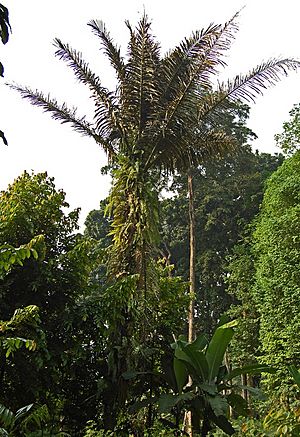Sugar palm facts for kids
Quick facts for kids Sugar palm |
|
|---|---|
 |
|
| Scientific classification | |
| Genus: |
Arenga
|
| Species: |
pinnata
|
The Arenga pinnata is a very useful palm tree that grows in warm, tropical parts of Asia. You might know it by other names like sugar palm, areng palm, or kaong palm. It is found from eastern India all the way to Malaysia, Indonesia, and the Philippines. This palm is important because many parts of it can be used for different things.

Contents
What the Sugar Palm Looks Like
This palm tree can grow quite tall, up to 20 meters (about 65 feet). Its trunk stays covered by rough old leaf bases. The leaves are very long, about 6 to 12 meters (20 to 40 feet) in length and 1.5 meters (5 feet) wide. They have many smaller leaf parts called pinnae. These pinnae are about 40 to 70 centimeters (16 to 28 inches) long.
The fruit of the sugar palm is roundish and about 7 centimeters (2.75 inches) across. It starts green and turns black when it is ripe.
Sugar Palm in Nature
The Arenga pinnata palm is a food source for some animals. For example, it is part of the diet of cloud rats, which are endangered species.
This palm is not a threatened species, meaning it is not in danger of disappearing. However, it can be rare in some local areas.
How People Use the Sugar Palm
People use many parts of the sugar palm. It is a very important plant in the countries where it grows.
Sweet Sap from the Palm
The sap from the sugar palm is collected in Southeast Asia. This sap is used to make a type of sugar called gur in India or gula aren in Indonesia.
- Sweet Drink: The sap can be made into a traditional cold, sweet drink called lahang.
- Vinegar: The sap can also be fermented to make vinegar. In the Philippines, this is called sukang kaong.
- Traditional Drinks: People also ferment the sap to make traditional drinks like tubâ in the Philippines or tuak in Malaysia and Indonesia.
To make sugar, the fresh sap is boiled until it becomes a thick syrup. This syrup is then dried into a brown sugar. People sometimes add crushed chili or ginger to the collecting containers to stop the sap from fermenting. Other sugar palms, like the buri palm, are used in similar ways to make sugar.
Delicious Fruit
The young fruits of the sugar palm are eaten in the Philippines and Indonesia. They are called kaong in the Philippines and buah kolang-kaling in Indonesia. These fruits are often boiled in sugar syrup and sold as canned fruits.
Strong Fibers
The dark, strong fibers from the palm's bark are very useful. These fibers are called doh in India and ijuk in Indonesia. In the Philippines, they are known as yumot or cabo negro.
These fibers are used to make many things:
- Ropes and cords
- Brushes and brooms
- Roofing for houses (thatch)
- Filters
Ancient temples in Java, like Borobudur, show buildings with roofs made from these fibers. Today, you can still see them on Balinese temple roofs and on the unique curved roofs of Minangkabau houses in Indonesia.
Useful Leaves
The leaves of the sugar palm, especially their strong midribs, can be used for weaving. People make baskets and decorative patterns for furniture from them.
Palm Starch
In Indonesia, starch can be taken from the sugar palm. This starch can be used instead of rice flour to make noodles, cakes, and other dishes.
Survival Food
In survival situations, the seeds of the sugar palm can be boiled and eaten. The tips of the palm's stem can also be eaten as vegetables. Even the juice from young flower stalks can be collected.
Sugar Palm in Culture
The sugar palm is important in the culture of some places.
- Irok Festival: In the Philippines, the town of Indang in Cavite holds an annual Irok Festival. Irok is a local name for the sugar palm. This town is a big producer of kaong fruits, sukang kaong (palm vinegar), and tubâ (a traditional drink).
- Folklore: In Sundanese stories, a spirit called Wewe Gombel is said to live in the Arenga pinnata palm. She supposedly has her nest there and keeps children she takes.
Gallery
-
Fruits harvested from Java
See also
 In Spanish: Arenga pinnata para niños
In Spanish: Arenga pinnata para niños





